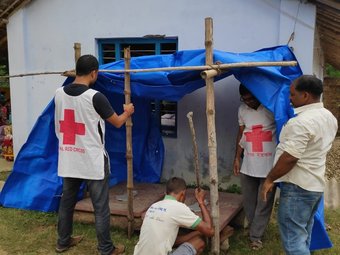Categories
Nepal
Key facts
Hazards covered by anticipation
Cold waves | Riverine floods
Anticipation partners in country
Nepal Red Cross Society | Danish Red Cross | Humanity & Inclusion | WFP | Red Cross Red Crescent Climate Center | UNICEF | Federal and provincial government stakeholders and agencies relevant to forecast-based action and shock-responsive social protection in Nepal | OCHA
Inform Risk Index (2022)
Hazard and exposure: 5.0
Vulnerability: 4.3
Lack of coping capacity: 5.7
Total: 5.0 (high)
Rank: 44
Country profile
Located in the central Himalaya, Nepal’s climate and topography expose it to diverse hazards. It has five climatic zones, ranging from tropical to artic and corresponding to different elevations along the mountain range.
Its steep mountain sides contribute to hazards including landslides, flash floods, glacial lake outbursts and avalanches. Nepal is also susceptible to cold waves, floods, earthquakes, drought, epidemics and fires. According to historical records, each of these hazards caused fatalities and destroyed housing and infrastructure during the period 1971-2011.
Floods caused by intense rainfall during the monsoon season are among the most damaging events, contributing to the loss of life, damage to infrastructure and loss of crops. Floods also contribute to erosion and landslides, which cause further deaths and destruction.
Projects
Since 2016, WFP has been partnering with the Nepal Red Cross Society, the Danish Red Cross and Practical Action Consulting to develop anticipatory action for riverine floods.
Forecast-based action and shock-responsive social protection in Provinces 5 and Sudhur Paschim, Nepal
This project, which started in 2020, aims to integrate shock responsiveness and anticipatory action into Nepal’s social security allowance programme. This will inform the development of more responsive and anticipatory social protection systems and early warning systems, which protect the most vulnerable people before, during and after shocks.
View the project page here.
Piloting forecast-based action in Nepal
Since 2018, the Nepal Red Cross Society, with support from the Danish Red Cross and the Climate Centre, has been working to develop and scale up forecast-based action for riverine floods.
View the project page here.
The objective of this pilot project is to provide collective anticipatory humanitarian action to people at risk of predicted severe monsoon flooding in Nepal. The project aims to provide life-saving assistance to over 80,000 people across 23 flood-prone municipalities (palikas). These are:
- in eastern Nepal: Province No. 1, Sunsari district (five palikas); Province No. 2, Saptari district (seven palikas)
- in western Nepal: Lumbini Province, Banke district (three palikas); Lumbini Province, Bardiya district (six palikas); Sudurpaschim Province, Kailali district (two palikas).
Read more about the project here.



